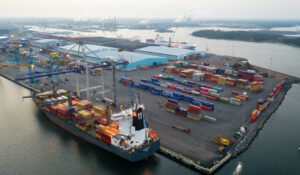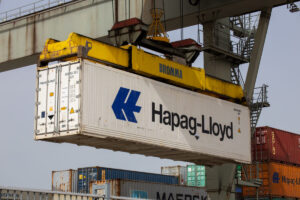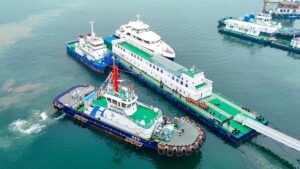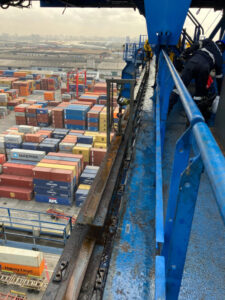Demand for cloud technology at ports is on the rise, according to a recent Navis customer survey. The survey reported that market interest in cloud solutions has increased by nearly 40% compared to the same time last year, demonstrating a growing desire in the industry to move Terminal Operation Systems (TOS) and IT operations to the cloud.
The events of 2020 and the impact of the COVID-19 pandemic on ports appears to have provided an acceleration in the willingness to take the plunge into cloud technology – according to the Navis survey, 79% of respondents have already created a timeline to move operations to the cloud. The pandemic has shown many that there is a need to be able to change to survive and the cloud provides this opportunity for change.
Speaking to PTI, Andy Barrons, Chief Strategy Officer, Navis, said that there has been change over the last couple of years in terms of moving some systems to the cloud, which have typically been administrative systems, but now there is a real demand for the TOS to move in the same direction.
The reason the TOS has not yet moved to the cloud in a widespread way yet is because it is a real-time, mission critical platform. “It has been easier to move some other systems first,” explained Barrons, “Today, in the supply chain around 50% of systems are now in the cloud.”
Now it is time for the TOS to make the move and Navis is providing a fully cloud based TOS with its Navis N4 and Octopi solutions, offering existing and new customers the opportunity to move on-premises systems to the cloud.
“Navis wants to be a guide to our customers when moving to the cloud,” Barrons said. “Today, we are able to provide all the capability available in N4 and Octopi, as a service in the cloud. We can implement the move from on-premise to the cloud and manage that solution in the future as well as offering upgrades.”
Cost efficiency is playing a large role in the drive towards cloud operations because it is costly for a terminal to run its own data centre.
“Is that really needed in the future?” Barrons questioned.
Cloud infrastructure can also be run across multiple sites, which is a lot more scalable and flexible and is able to incorporate upgrades and updates easily.
Navis has supported cloud TOS solutions since 2017 and has deployed them for various customers around the world, including in Finland, the US,the Caribbean, Asia and Africa. Barrons noted that the latter can be particularly challenging because of connectivity issues in Africa but they have still been able to implement the solution.
“I see an acceleration of deployment [of the cloud solution] over the next five years,” Barrons said. “But we will still have a mix of cloud and on-premise solutions and will continue to offer both.”
Key considerations
Barrons said the main considerations for ports and terminals when moving their TOS to the cloud include numerous elements.
First consideration is infrastructure reliability, can the infrastructure support the uptime requirements? Second, there needs to be transparency of the system and a trust center for monitoring uptime and preventing issues, this means there must be real-time visibility to catch any issues quickly and address them immediately.
Security of course continues to be a top priority for any digital implementation and there is a need for both prevention and access controls as well as application and data security. Barrons noted that cloud solutions today are more secure than older on-premise solutions.
There is also a need for the skills and the capability to provision the TOS for the cloud environment, manage the system and maintain compliance with the data privacy standards and regulations that these systems must adhere to.
Finally, operational excellence in the area of deployment and automating and standardizing processes, this is an area that the Navis team has worked on to streamline N4 cloud deployment, Barrons said.
In the cloud and beyond
Beyond the cloud and despite the challenges of COVID-19, Navis has had a successful year with numerous go-lives for its TOS solution which have been carried out remotely. “Online testing and training have been carried out, as the professional services team were quick to shift to remote working,” noted Barrons.
For Navis, there has been a strong focus on innovation with the engineering and product team and the company has been working on various elements of automation over the past few years.
“We saw a wave of automated terminal projects from 2016 to 2019 and now we are seeing automation continuously improving performance and exceeding 30 mph. In the next wave we want to accelerate the time to value and ease of use,” Barrons noted, adding, “rubber tyred gantry crane optimization is an increasingly important opportunity for the industry.”
He also highlighted other developments including the Navis Smart Suite in the cloud and mobile apps which provides a range of workflow and planning tools including reefer, lashing and pinning applications are being used by Terminals. The Navis Smart Compass application has already been adopted by Yilport and other terminals across the globe.
Beyond the terminal, the company is expanding into the inland logistics space with rail freight planning applications, following the acquisition of Australia-based Biarri Rail in early 2020. This marked the first step for the company in offering planning and operations solutions to rail freight logistics companies, as the company looks to expand its reach across the global supply chain.
In the next decade we will surely see a wave of innovation which Barrons said would be enabled by the cloud.








